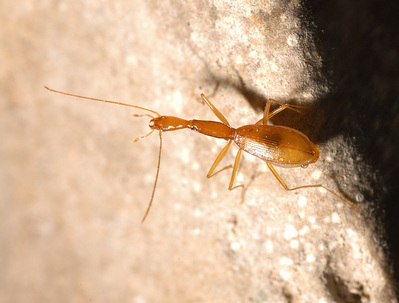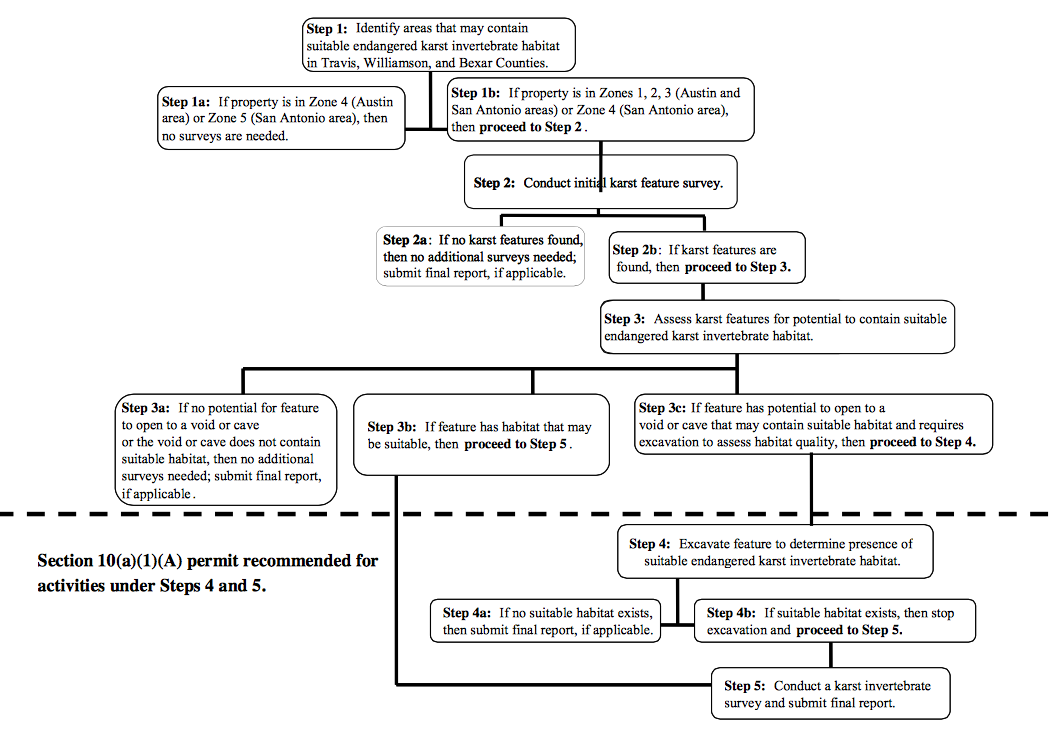Endangered Karst Invertebrate Habitat Surveys
Overview
 Federally listed Rhadine exilis
Federally listed Rhadine exilis
Invertebrate species that are specifically adapted to live their entire lives in caves are known as karst invertebrates. Karst invertebrates have adaptations such as reduced or absent eyes, low pigment, and longer appendages. Caves, sinkholes, fractures, enlarged bedding planes, and the mesocavernous connections formed from dissolved limestones host a wide variety of species that have evolved to live all or some portion of their life in subterranean cave environments. Karst invertebrates need high humidity, stable temperatures, and surface-derived nutrient sources to survive. Karst invertebrates can also be highly limited in range due to lack of connectivity in cavernous rock units.
The Endangered Species Act is a federal law that prohibits take of any listed species by any means, including harm, harassment, trapping, collection, and habitat destruction resulting in death or injury to a listed species. The USFWS listed seven karst invertebrates from Travis and Williamson County as endangered in 1994, granting them protection under the Endangered Species Act. Nine additional karst invertebrates from Bexar County were listed as endangered in 2000. Critical Habitat for Bexar County karst invertebrates was designated by the USFWS in 2012. Prior to conducting fieldwork, you should consult the "United States Fish and Wildlife Service, Section 10(a)(1)(A) Scientific Permit Requirements for Conducting Presence/Absence Surveys for Endangered Karst Invertebrates in Central Texas", which outlines the Service’s survey requirements under a section 10(a)(1)(A) permit for conducting presence/absence surveys for federally listed endangered, terrestrial karst invertebrate species in Travis, Williamson, and Bexar Counties, Texas. Remember that any activity that may result in take of listed species must be overseen by a person holding a 10(a)(1)(A) permit for federally listed karst invertebrate species. This includes entering a cave or excavating or modifying a karst feature that may contain endangered karst invertebrate habitat.
The Endangered Species Act is a federal law that prohibits take of any listed species by any means, including harm, harassment, trapping, collection, and habitat destruction resulting in death or injury to a listed species. The USFWS listed seven karst invertebrates from Travis and Williamson County as endangered in 1994, granting them protection under the Endangered Species Act. Nine additional karst invertebrates from Bexar County were listed as endangered in 2000. Critical Habitat for Bexar County karst invertebrates was designated by the USFWS in 2012. Prior to conducting fieldwork, you should consult the "United States Fish and Wildlife Service, Section 10(a)(1)(A) Scientific Permit Requirements for Conducting Presence/Absence Surveys for Endangered Karst Invertebrates in Central Texas", which outlines the Service’s survey requirements under a section 10(a)(1)(A) permit for conducting presence/absence surveys for federally listed endangered, terrestrial karst invertebrate species in Travis, Williamson, and Bexar Counties, Texas. Remember that any activity that may result in take of listed species must be overseen by a person holding a 10(a)(1)(A) permit for federally listed karst invertebrate species. This includes entering a cave or excavating or modifying a karst feature that may contain endangered karst invertebrate habitat.
Below is a flowchart to help you determine when habitat surveys and a 10(a)(1)(A) permit is required.
Step 1 a and b: Identify karst zone property is located in
Properties in Karst Zone 1, 2, 3, or 4 in the San Antonio area should be surveyed for karst features. Map courtesy of USFWS.
Properties in Karst Zone 1, 2, or 3 in the Austin area should be surveyed for karst features. Map courtesy of USFWS.
Step 2: Conduct initial karst feature survey
Prior to surveying, you should submit a formal data request to the Texas Speleological Survey in order to obtain locations for known caves and karst features, and review previously conducted Geologic Assessment files at the Texas Commission on Environmental Quality (TCEQ) Austin and San Antonio regional offices. Survey methods are based on the Procedure for Conducting a Geologic Assessment in the Texas Commission on Environmental Quality’s (TCEQ) Instructions to Geologists for Conducting Geologic Assessments. This is also Step 2 (pg. 4-6) in the USFWS Survey Requirements.Surveys are performed by methodically sweeping the subject property so that the entire property is visually inspected for signs of karst features such as sinkholes, fractures, caves, etc. This is typically accomplished by forming a line with 3-5 crew members and sweeping back and forth across the property in straight lines. The edge of each transect is usually marked with pieces or biodegradable toilet paper to ensure that the entire property is examined.
Step 3: Assess features for potential to contain suitable karst invertebrate habitat
The the USFWS requires that the potential for a karst feature to contain suitable endangered karst invertebrate habitat be evaluated by a biologist or geologist with experience in karst geology and the ability to identify cave-adapted invertebrate species. Features likely to contain endangered karst invertebrate habitat have several characteristics in common such as a connection to the surface through which nutrients may flow into the feature, either by hydrologic, or biologic processes. Features with signs of significant recharge, collapse or the presence of cave crickets should be examined closely. You should be very familiar with the USFWS Survey Requirements and the indicators of potential karst invertebrate habitat. If potential endangered karst invertebrate habitat is visible without the need for excavation, a qualified person holding a 10(a)(1)(a) permit should complete Step 5: Karst invertebrate surveys.
Step 4: Excavate feature to determine presence of suitable karst invertebrate habitat
If excavation is required to determine if the feature may contain endangered karst invertebrate habitat, a qualified person holding a 10(a)(1)(a) permit should oversee the excavation. Refer to the USFWS Survey Requirements for detailed instructions.
Step 5: Conduct a karst invertebrate survey and submit a final report
If surveys are required to determine the presence or absence of endangered karst invertebrates, a qualified person holding a 10(a)(1)(a) permit should conduct the surveys. Refer to the USFWS Survey Requirements for detailed instructions.

